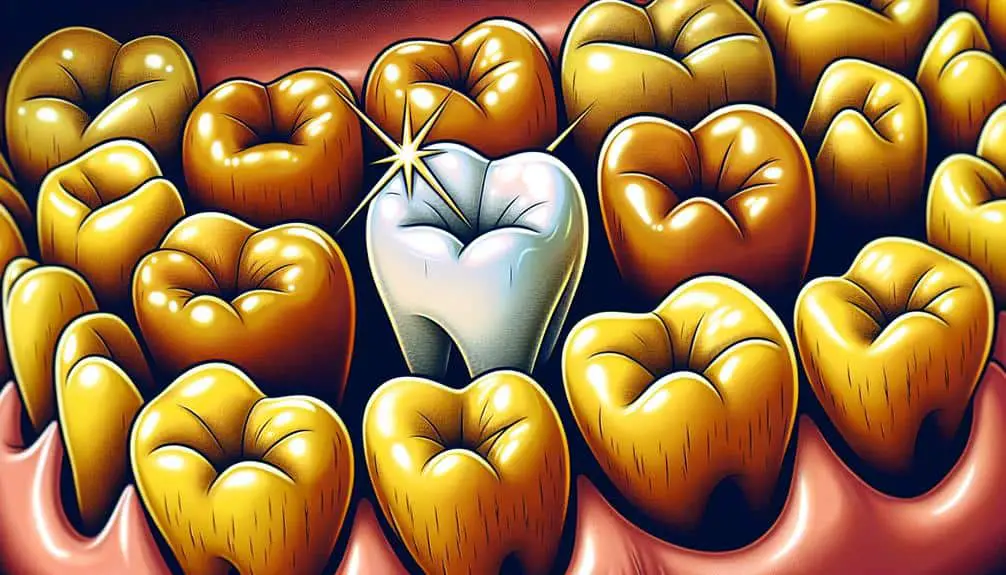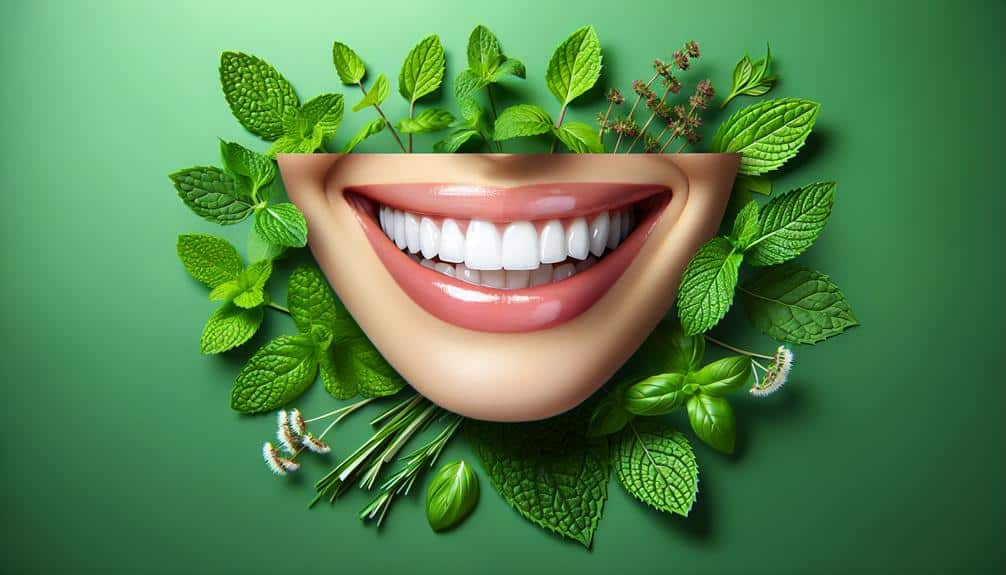For effective removal of old age stains on your teeth, opt for a whitening toothpaste that contains hydrogen peroxide, abrasives like silica, and fluoride. Hydrogen peroxide acts as a bleaching agent that helps eliminate stubborn stains, while abrasives help scrub away surface discoloration. Fluoride aids in protecting your enamel and overall dental health. Consider top brands such as Crest 3D White Brilliance, Colgate Optic White Express, or Sensodyne Pronamel Gentle Whitening for successful stain removal. Make an informed choice based on key ingredients and user satisfaction to achieve a brighter smile with effective stain removal.
Key Points
- Look for toothpaste with hydrogen peroxide for effective stain removal.
- Consider toothpaste with baking soda for natural whitening properties.
- Choose a brand with fluoride for enamel protection and strength.
- Opt for toothpaste with abrasive particles to scrub away surface stains.
- Consult a dentist for personalized recommendations, especially for sensitive teeth or gums.
Types of Old Age Stains
When considering the types of old age stains that commonly affect teeth, it's important to understand the underlying causes for effective treatment with the best toothpaste.
Two primary culprits responsible for such stains are coffee and tobacco. Coffee stains develop gradually over time due to the dark pigments present in coffee beans. These pigments adhere to the enamel surface of the teeth, leading to discoloration if not properly addressed. Similarly, tobacco stains are caused by the tar and nicotine found in tobacco products. These substances also stick to the tooth enamel, resulting in yellow or brownish stains that can be challenging to remove.
Coffee and tobacco stains are notorious for their stubborn nature, requiring specialized toothpaste formulations to effectively address them. The best toothpaste for combating these stains typically contains abrasive particles that help scrub away the surface discoloration without causing damage to the enamel. Additionally, these toothpastes often incorporate whitening agents to further lift and remove the deep-seated stains caused by coffee and tobacco.
Understanding the specific characteristics of these stains is essential in selecting the most suitable toothpaste for effective removal.
Key Ingredients in Whitening Toothpaste
To effectively address old age stains like coffee and tobacco discoloration on teeth, understanding the key ingredients in whitening toothpaste is essential. Whitening toothpaste often contains several key components that contribute to its effectiveness. One common ingredient found in whitening toothpaste is hydrogen peroxide, which acts as a bleaching agent to lighten stains on the teeth. Another important ingredient is abrasive particles such as silica, calcium carbonate, or alumina, which help to physically scrub away surface stains. Some whitening toothpaste brands also incorporate natural alternatives like baking soda or activated charcoal, known for their mild whitening properties.
When considering whitening toothpaste, it's vital to be aware of the chemical composition and potential abrasive properties. Some individuals may experience sensitivity concerns when using whitening toothpaste regularly due to the abrasive nature of certain ingredients. It's advisable to consult with a dentist if you have sensitive teeth or gums to make sure the toothpaste is appropriate for your specific needs.
How Whitening Toothpaste Works
Whitening toothpaste works by utilizing key ingredients that target and remove surface stains on teeth, restoring a brighter and healthier smile. These ingredients work together to guarantee effective stain removal while also safeguarding the enamel of your teeth.
Here's how whitening toothpaste achieves its results:
- Enamel Protection: Whitening toothpaste contains ingredients like fluoride and calcium phosphate that help strengthen and protect the enamel of your teeth. This protection is essential as enamel is the outer layer of the teeth and plays an important role in preventing tooth decay and sensitivity.
- Stain Removal: The active ingredients in whitening toothpaste, such as hydrogen peroxide and carbamide peroxide, act as bleaching agents that penetrate the tooth surface to break down and remove stains. Additionally, the abrasives in the toothpaste help mechanically scrub away surface stains, revealing a whiter smile.
- Overall Brightening Effect: By combining enamel protection with effective stain removal, whitening toothpaste not only helps in achieving a whiter appearance but also contributes to maintaining overall dental health.
Factors to Consider When Choosing
When selecting a toothpaste for eliminating age-related discoloration, it's crucial to consider several key factors to ensure maximum effectiveness and safety.
To begin with, consider the toothpaste's efficacy in removing stains. Look for toothpaste specifically designed to target and break down stubborn discoloration caused by aging. Ingredients like hydrogen peroxide, baking soda, and fluoride are known to be effective in this respect.
Next, explore consumer reviews. Learning about others' experiences can offer valuable insights into the toothpaste's actual performance. Look for reviews that mention successful stain removal and overall satisfaction with the product. Additionally, take into account any potential side effects or sensitivities reported by users.
Top Whitening Toothpaste Brands
Explore the top brands of toothpaste known for their exceptional whitening properties. When selecting a whitening toothpaste, look for options that not only brighten your smile but also provide additional benefits such as sensitivity relief and enamel protection.
Here are three top whitening toothpaste brands to explore:
- Crest 3D White Brilliance Toothpaste: This toothpaste is renowned for its advanced whitening technology that effectively removes surface stains while also strengthening the enamel. It contains fluoride for enamel protection and is gentle on sensitive teeth.
- Colgate Optic White Express White Toothpaste: Colgate's Optic White toothpaste is formulated with hydrogen peroxide, a potent whitening agent that can deliver noticeable results in just a few days. It also helps protect against cavities and provides sensitivity relief.
- Sensodyne Pronamel Gentle Whitening Toothpaste: Sensodyne is a trusted brand for sensitivity relief, and their Pronamel Gentle Whitening toothpaste combines whitening properties with enamel protection. It helps to strengthen and re-harden enamel while effectively removing stains for a brighter smile.
Frequently Asked Questions
Can Using Whitening Toothpaste Remove Stains Caused by Medications or Medical Conditions?
Using whitening toothpaste may not be effective against stains caused by medications or medical conditions. Explore alternatives like professional dental cleanings or specialized toothpaste for denture care to address these specific concerns.
Are There Any Potential Side Effects or Risks Associated With Using Whitening Toothpaste on Old Age Stains?
When using whitening toothpaste on old age stains, potential risks include increased sensitivity. Monitoring any discomfort is crucial. Long-term effectiveness varies, with results usually visible over weeks. Consult your dentist for personalized advice.
How Long Does It Typically Take to See Results When Using Whitening Toothpaste on Old Age Stains?
When using whitening toothpaste for old age stains, applying it twice daily increases effectiveness. Visible results usually appear within 2-6 weeks. Consistent application is key for best outcomes. Patience and regular use are essential.
Are There Any Alternative Methods or Treatments for Removing Old Age Stains Besides Whitening Toothpaste?
When it comes to removing old age stains, explore natural remedies like baking soda and hydrogen peroxide, or seek professional treatments such as cosmetic dentistry. DIY solutions may work, but for more stubborn stains, consider professional options.
Can Whitening Toothpaste Be Used on Dentures or Other Dental Prosthetics to Remove Old Age Stains?
For removing old age stains from dentures or dental prosthetics, consider specialized whitening options. Denture care is essential, and selecting suitable whitening products is pivotal. Follow recommended guidelines for stain removal to maintain prosthetic longevity and appearance.



